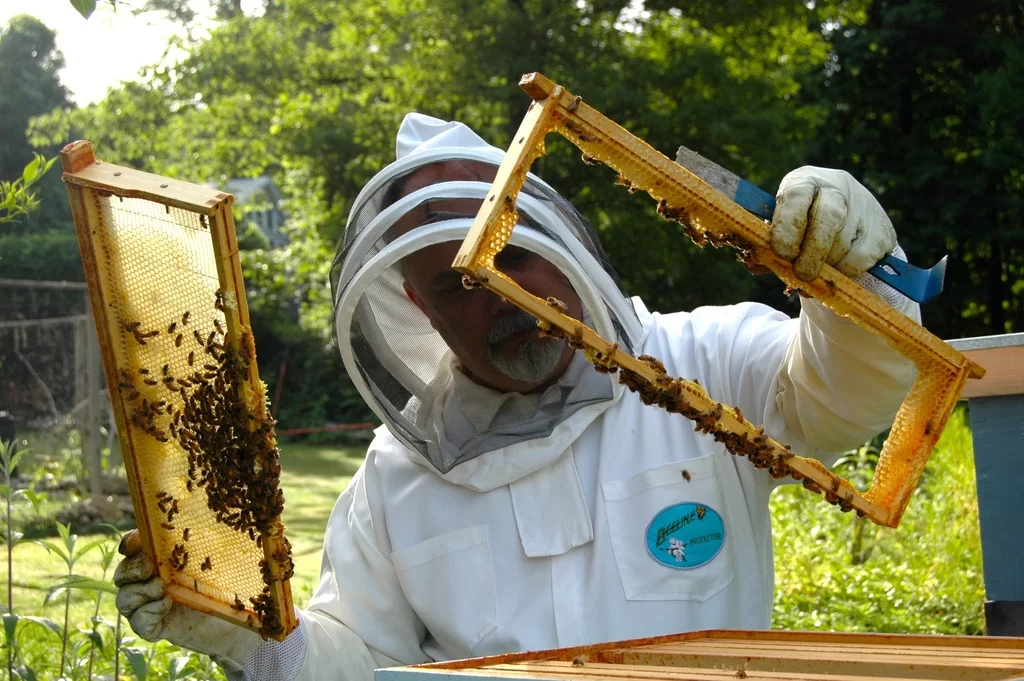A basic rule for beekeepers is: “Never go to the hives without smoke!” The smoke makes the bees think there is a forest fire. They prepare for a possible evacuation and “pack their bags”: they fill their bellies with honey.
A full honey stomach makes the bees “gentle”. Then they won’t sting as quickly. In addition, they are a bit distracted with the “packing”…

There’s nothing more frustrating than having a smoker keep going out – especially when you need it most. You should therefore choose a smoker with an internal smoke box that has holes not only at the bottom but also on the side.
If necessary, you can drill a few additional holes yourself. The “Api Smoker Classic” or “Rauchboy” is certainly a good choice. 10 cm diameter burns better than 8 cm.
However, since we are not professional beekeepers and the smoker actually only has to burn for a relatively short time (reliably), a smaller diameter is also sufficient. The perforated inner box is more important.
You can also buy lighters and fuel (“smoky herbs”) in beginning beekeeping supplies.
This need not be! Since we do not have to make long interventions in the bee colonies or not have to process many bee colonies, the following fuel is also sufficient: Old egg cardboard is ideal as a lighter, and wood shavings (eg small animal litter from the supermarket) as fuel.
You can also mix this with some dried, chopped plant remains and leaves and add some fresh grass on top. Some beekeepers swear by small animal litter made from hemp stalks. You can also use “eco” grill lighters as lighter.
The main thing is that it smokes nicely…
Read Also:
The thought of exposing yourself unprotected to a huge number of bees tends to scare a beginner in particular. Whether a bee colony is more gentle or more defensive depends on many factors.
It is good to step in front of the bees with a so-called “veil” at the beginning. This relaxes the beekeeper and indirectly also the bees, to whom the nervousness of the beekeeper can easily be transferred.
A blouson with a firmly attached hood (“protective shirt”) and long sleeves (elastic in the cuffs) is the safest to use.
Gloves are actually not necessary for normal work on the colony. Nevertheless, it’s good to have some ready, because you can’t leave the open bee box like that and flee if the bees should have “a bad day”. Sturdy rubber gloves (resilient household gloves) are sufficient.
The bees sit very quietly in the bee box and opening the box also makes them less aggressive than is the case with other bee boxes. With simple checks (when using the smoker) you don’t have to expect bees to sting.
But you will still be buzzed by numerous bees, and at the beginning, you cannot judge very well whether the bees are just flying around or whether they want to sting in the near future.
Since the bee box has to be moved to open it, bees that are on their way cannot return to the box while it is open. They rotate “queues” in front of the crate. Since they have a full honey stomach (see above), they pose no danger.
Over time, you can assess for yourself whether protective clothing is necessary for the planned work or not. But you should always have them with you so that you can still wear them if necessary.
If you don’t wear a face veil, you should at least put something on your head. Bees easily get caught in the hair and then get nervous because they can no longer free themselves so easily.
We need a stick chisel with which we can loosen the bottom board once it has been cemented in place with propolis by the bees. You can also use the stick chisel to cut through combs and scrape propolis and wax residue from the inside walls.
For the bee box, the only useful stick chisel that is available everywhere is the “American stick chisel, long 23 cm”. With this, you can just about cut through the honeycombs (which can be a maximum of 20 cm high).
In addition, a knife with a long blade (at least 25 cm) is useful when harvesting honey.
We also need a bee broom. With it, the bees are swept off the honeycomb during the honey harvest. It can also be used to sweep bees off the edges of the bee box before replacing the bottom to avoid crushing bees in the process.
A water atomizer (a very simple model for wetting flowers) is also useful for dealing with a swarm of bees.